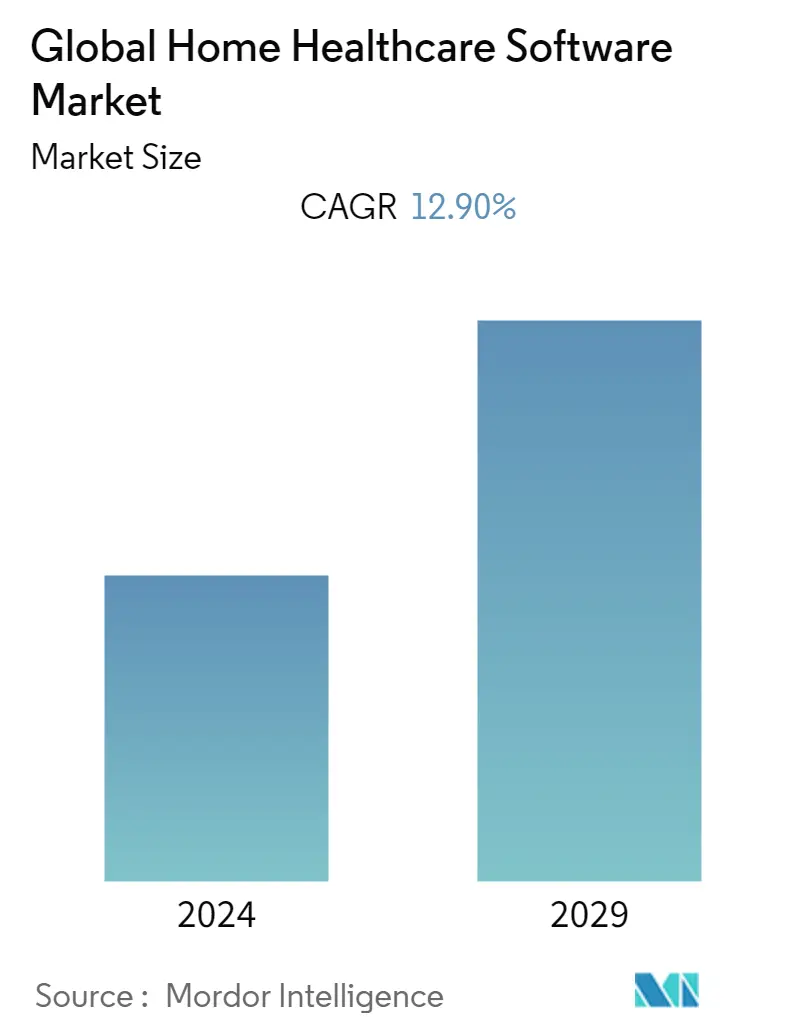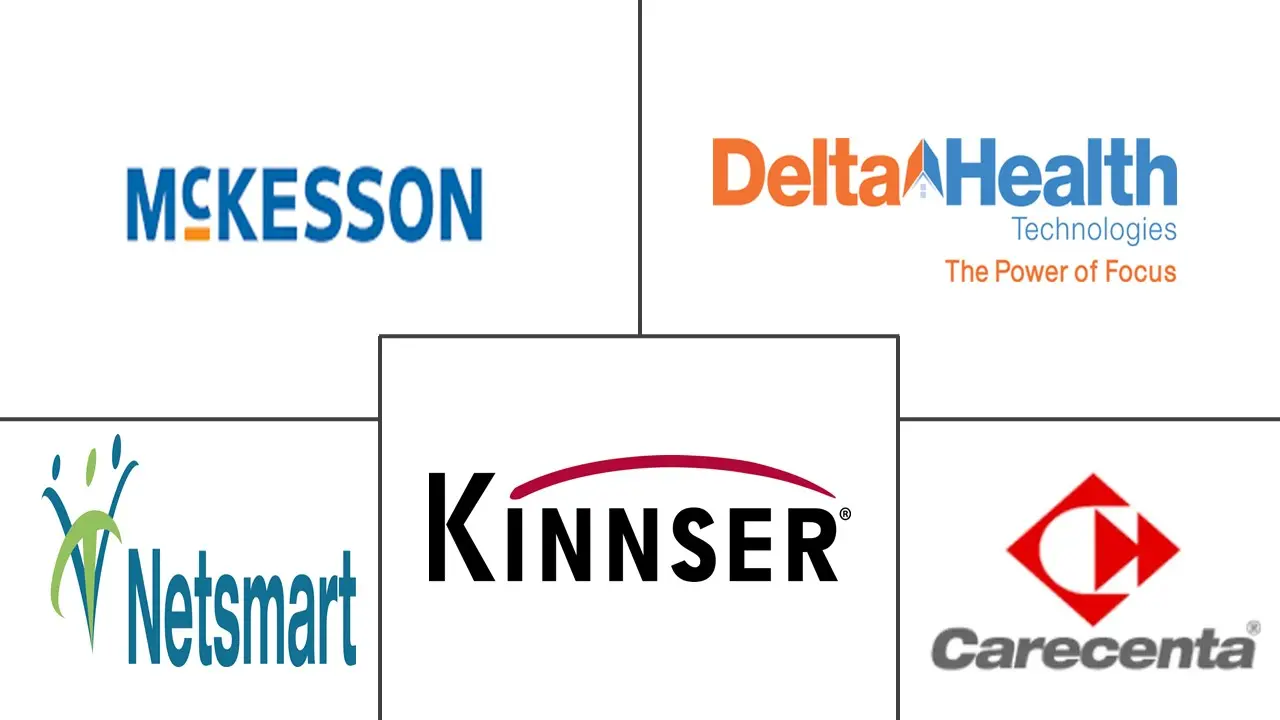Market Size of Global Home Healthcare Software Industry

| Study Period | 2019 - 2029 |
| Base Year For Estimation | 2023 |
| CAGR | 12.90 % |
| Fastest Growing Market | Asia Pacific |
| Largest Market | North America |
| Market Concentration | Low |
Major Players
*Disclaimer: Major Players sorted in no particular order |
Home Healthcare Software Market Analysis
The home healthcare software market is poised to grow at a CAGR of 12.9% during the forecast period, 2022-2027.
The COVID-19 pandemic has put enormous pressure on the healthcare system causing many healthcare organizations to cancel or stop elective procedures in hospitals and other healthcare settings during the initial phase of the pandemic which is expected to have a significant impact on the home healthcare software market as demand for home care services grew during the pandemic. For instance, according to an article published in January 2022, titled 'How COVID-19 Reinforced the Important Role of Home Health Care', to keep patients safe at home, home health providers have been spurred on by the pandemic to further modify their service offerings with new technologies and improved infection prevention techniques and demand for home healthcare services grew during the pandemic. Therefore, the COVID-19 pandemic is expected to have a significant impact on the home healthcare software market.
The major factors for the growth of the home healthcare software market include the rapid rise in the aging population, increasing awareness triggering the adoption rate, and significant technological advancements leading to cost-effectiveness and ease of use.
The global population is aging rapidly, owing to reducing birth rates and increasing life expectancy, and it may result in a high prevalence of chronic diseases as the older population are more susceptible to chronic diseases owing to the aging and low immunity which is expected to create demand for home healthcare services and software. For instance, according to the October 2021 report of the World Health Organization, the global population of people of age 60 years and more is expected to increase from 1 billion in 2020 to 2.1 billion by 2050, which is expected to have a significant impact on the home healthcare software market and older people are more dependent upon others for their care and other needs.
Furthermore, the growing adoption of home healthcare products and services in different parts of the world is anticipated to boost the market over the forecast period. For instance, according to the Center for Medicare and Medicaid Services 2021, every year, home healthcare helps hundreds of thousands of high-risk patients avoid being readmitted to the hospital and make the most of their healthy days at home. Also, as per the same source, clients who use home healthcare report a 76% reduction in readmission rates, an average of 89% patient satisfaction, and a total medical cost savings of nearly USD 370 million. Therefore, the growing popularity of home healthcare services is expected to increase the demand for the software used in home healthcare services, and thus, the market is expected to grow over the forecast period.
Various strategies adopted by the key market players such as product launches and partnership is further expected to augment the growth of the studied market. For instance, in July 2021, Homecare HomebaseSM (HCHB) software for home health and hospice, is partnering with global digital wound care leader Swift Medical to provide high-quality, cost-efficient care through an integrated solution. Through this expanded partnership, Swift Medical becomes the exclusively preferred wound care technology partner for HCHB, with an enhanced integration offering to streamline workflows and eliminate double documentation. Therefore, due to the above-mentioned factors, the home healthcare software market is expected to grow over the forecast period. However, affordability issues among emerging economies and insufficient technical support are expected to restrain the growth of the home healthcare software market over the forecast period.
Home Healthcare Software Industry Segmentation
As per the scope of this report, home healthcare software refers to the application of information processing that involves computer software dealing with the retrieval, storage, sharing; and usage of healthcare information, data, and knowledge for communication and decision-making purposes. This software is designed for companies that employ home healthcare providers, as well as government entities that track payments to home healthcare providers. The home healthcare software market is segmented by software (agency management, clinical management, hospice software solutions, and other software), service (rehabilitation, infusion therapy, respiratory therapy, pregnancy care, skilled nursing, and others), mode of delivery (cloud-based software, on-premises software, and others), and geography (North America, Europe, Asia-Pacific, Middle East and Africa, and South America). The market report also covers the estimated market sizes and trends for 17 different countries across major regions, globally. The report offers the value (in USD billion) for all the above segments.
| By Software | |
| Agency Management | |
| Clinical Management | |
| Hospice Software Solutions | |
| Other Software |
| By Service | |
| Rehabilitation | |
| Infusion Therapy | |
| Respiratory Therapy | |
| Pregnancy Care | |
| Skilled Nursing | |
| Others |
| By Mode of Delivery | |
| Cloud-Based Software | |
| On-Premises Software | |
| Others |
| Geography | ||||||||
| ||||||||
| ||||||||
| ||||||||
| ||||||||
|
Global Home Healthcare Software Market Size Summary
The home healthcare software market is experiencing significant growth, driven by the increasing demand for home care services, particularly highlighted during the COVID-19 pandemic. The pandemic prompted a shift towards home-based care to ensure patient safety, thereby accelerating the adoption of home healthcare software solutions. Key factors contributing to market expansion include the rapid aging of the global population, which is more susceptible to chronic diseases, and the rising awareness and adoption of home healthcare technologies. These advancements offer cost-effective and user-friendly solutions, further boosting market growth. The growing popularity of home healthcare services, supported by positive outcomes such as reduced hospital readmission rates and increased patient satisfaction, is expected to sustain the demand for related software solutions.
The market is characterized by strategic initiatives from key players, including product launches and partnerships, which are anticipated to further enhance market growth. The hospice software solutions segment is also expected to gain traction due to the increasing demand for hospice care, driven by the aging population and the rising incidence of life-threatening diseases like cancer. North America is projected to dominate the market, supported by advanced healthcare infrastructure and a growing elderly population. The region's robust IT infrastructure facilitates the adoption of innovative home healthcare software solutions. Despite challenges such as affordability in emerging economies and insufficient technical support, the market is poised for substantial growth, with a moderately concentrated landscape featuring both small and large players.
Global Home Healthcare Software Market Size - Table of Contents
-
1. MARKET DYNAMICS
-
1.1 Market Overview
-
1.2 Market Drivers
-
1.2.1 Increasing Awareness Regarding Homecare Technologies
-
1.2.2 Technological Advancements Leading to Cost Effectiveness and Ease of Use
-
1.2.3 Rapid Rise in the Aging Population
-
-
1.3 Market Restraints
-
1.3.1 Insufficient Technical Support
-
1.3.2 Affordability Issues among the Emerging Economies
-
-
1.4 Porter's Five Forces Analysis
-
1.4.1 Threat of New Entrants
-
1.4.2 Bargaining Power of Buyers/Consumers
-
1.4.3 Bargaining Power of Suppliers
-
1.4.4 Threat of Substitute Products
-
1.4.5 Intensity of Competitive Rivalry
-
-
-
2. MARKET SEGMENTATION (Market Size by Value - USD million)
-
2.1 By Software
-
2.1.1 Agency Management
-
2.1.2 Clinical Management
-
2.1.3 Hospice Software Solutions
-
2.1.4 Other Software
-
-
2.2 By Service
-
2.2.1 Rehabilitation
-
2.2.2 Infusion Therapy
-
2.2.3 Respiratory Therapy
-
2.2.4 Pregnancy Care
-
2.2.5 Skilled Nursing
-
2.2.6 Others
-
-
2.3 By Mode of Delivery
-
2.3.1 Cloud-Based Software
-
2.3.2 On-Premises Software
-
2.3.3 Others
-
-
2.4 Geography
-
2.4.1 North America
-
2.4.1.1 United States
-
2.4.1.2 Canada
-
2.4.1.3 Mexico
-
-
2.4.2 Europe
-
2.4.2.1 Germany
-
2.4.2.2 United Kingdom
-
2.4.2.3 France
-
2.4.2.4 Italy
-
2.4.2.5 Spain
-
2.4.2.6 Rest of Europe
-
-
2.4.3 Asia-Pacific
-
2.4.3.1 China
-
2.4.3.2 Japan
-
2.4.3.3 India
-
2.4.3.4 Australia
-
2.4.3.5 South Korea
-
2.4.3.6 Rest of Asia-Pacific
-
-
2.4.4 Middle East and Africa
-
2.4.4.1 GCC
-
2.4.4.2 South Africa
-
2.4.4.3 Rest of Middle East and Africa
-
-
2.4.5 South America
-
2.4.5.1 Brazil
-
2.4.5.2 Argentina
-
2.4.5.3 Rest of South America
-
-
-
Global Home Healthcare Software Market Size FAQs
What is the current Global Home Healthcare Software Market size?
The Global Home Healthcare Software Market is projected to register a CAGR of 12.90% during the forecast period (2024-2029)
Who are the key players in Global Home Healthcare Software Market?
Delta Health Technologies, Kinnser Software Inc., McKesson Corporation , Netsmart Technologies and CARECENTA, INC. are the major companies operating in the Global Home Healthcare Software Market.

